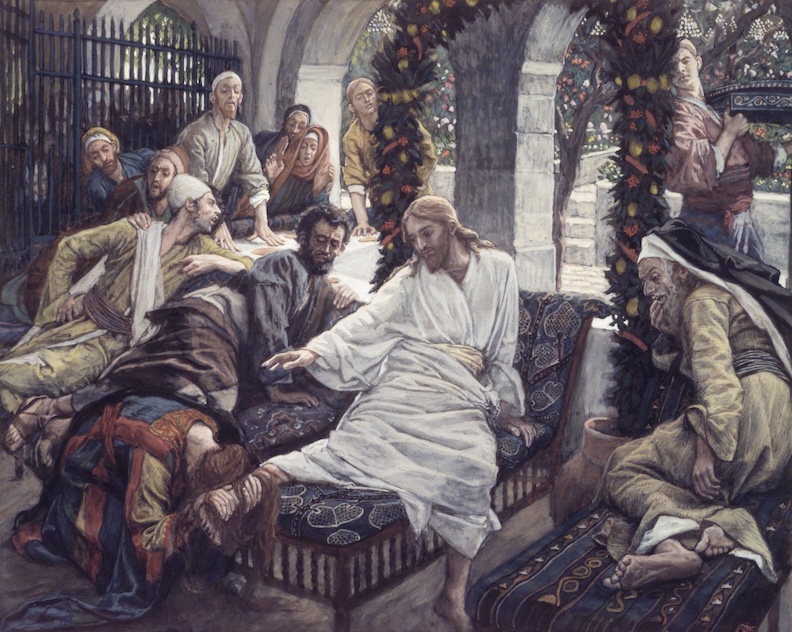There’s probably no better figure to lead us into Holy Week than Mary of Bethany. While Jesus was reclining at table, she “came with an alabaster jar of perfumed oil, costly genuine spikenard. She broke the alabaster jar and poured it on his head.” It’s an act that serves as an overture for the rest of the week. It sets the tone for events to come and illuminates the path of our penitence. Our Lord himself calls attention to its importance and solemnly declares, “Amen, I say to you, wherever the gospel is proclaimed to the whole world, what she has done will be told in memory of her.”
So, what is it exactly that she has done?
First, what she did was a prophetic act. In the tradition of the Old Testament prophets, Mary proclaims a truth not by words but by an act. Jeremiah put on a yoke to proclaim the coming enslavement of ancient Israel. Ezekiel ran away to signify their coming exile. And here Mary acts as a prophetess, proclaiming the truth about Christ and about what was going to happen.
The truth is that he is the Messiah, the Anointed One – the Christ. As kings and priests were anointed in ancient Israel, so Mary anoints Jesus to proclaim and reveal what he already is. She doesn’t make him the anointed one but by her devotion confesses him as the Christ.
The truth she proclaims about what is to come is made explicit by our Lord: “She has anticipated anointing my body for burial.” She proclaims his death – precisely the thing the Apostles were so deaf to. Thus, her actions proclaim him as both the Christ and the Victim for our sins. This prophetic act already reveals Mary as the “Apostle to the Apostles” (more on that below). Her prophetic act proclaims to them already what they will later proclaim to the nations.
But the most obvious meaning of her act is the complete and absolute giving of oneself to Jesus. That’s conveyed most of all by the financial waste, which the disciples pick up on immediately. Their reaction is harsh. They are “indignant” and “infuriated.” They rebuke her, “Why has there been this waste of perfumed oil? It could have been sold for more than three hundred days’ wages and the money given to the poor.” Indeed, the jar and oil combined could have totaled tens of thousands of dollars.
So, the reaction of the disciples is not surprising. They’re amazed at this waste. . .because in worldly terms it is a waste. And that’s the point, and probably the deeper reason for their discomfort. She did what they hadn’t yet done; she gave all. She squandered her savings out of love for Jesus. Her act expresses her estimation of Jesus; he’s worth everything. Judas only values him at thirty silver pieces.

Her acts are sacramentals, outward signs that reveal her interior devotion. She doesn’t just open the jar but breaks it. She doesn’t just dab some oil on his head but pours it over him. The extravagance here is a sign of abandonment and total commitment to Jesus.
We give ourselves to him partially, in drips and drabs. We apportion ourselves to him selfishly. But you can’t be half a saint, as Saint Therese put it. Yes, we all recognize our need to break things open and pour everything out for him. Mary actually did it.
Then there’s her willingness to look ridiculous. Which, it must be admitted, she does. She makes a mess of a broken jar and spilled oil. “The house was filled with the fragrance of the oil,” John tells us. It’s a spectacle. As we might say, “One doesn’t do such things.” Unless, of course, one is serious about proclaiming and following Jesus Christ. In that case, one is willing to look ridiculous, to incur the abuse and ridicule of the world.
By Baptism, we all have a share in Christ’s prophetic office. But we typically keep our powder dry – or our oil in the jar – out of slavery to human respect. What will people think? What will they say? Mary of Bethany teaches that to proclaim Christ means not to take account of such things.
Now, it’s unfortunate that in recent years we’ve strayed from the ancient tradition in the West that Mary of Bethany is also Mary of Magdala, the Apostle to the Apostles. In other words, that this Mary is also the Mary at the foot of the Cross on Good Friday, the Mary at the tomb on Easter morning, the Mary from whom our Lord had cast seven demons and who for centuries had (in liturgy and in art) the unique title The Penitent.
Presuming that identification of the two Marys, the shattering of the alabaster and the pouring of the oil is revealed as not only a prophetic but also a penitential act. It’s an expression of gratitude for sins forgiven. Here the prophetess and penitent intersect. She proclaims him as the Christ who has freed her from sin and possession.
This is an important association as we enter these last days of Lenten penitence. To repent means to recognize and proclaim Jesus as the Christ, the Victim for our sins, the One who frees us. It means to waste nothing in seeking his mercy, praising him for his forgiveness, and proclaiming his Kingship.















